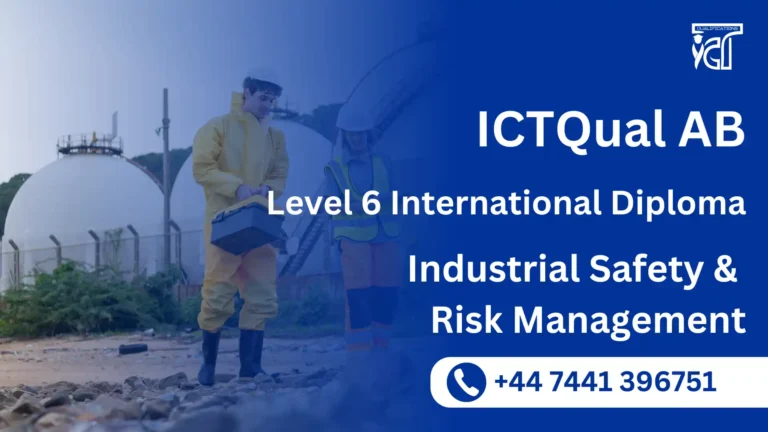If you’re aiming to elevate your career in occupational health and safety, the Qualifi Level 6 International Diploma in Safety Engineering (IDSE) is one of the most recognized and valuable qualifications available today. Whether you’re preparing for the Transitional Safety Practitioner (TSP) designation or planning to pursue the prestigious Certified Safety Professional (CSP) certification, this diploma is an ideal pathway.
The Qualifi Level 6 International Diploma in Safety Engineering is a UK-regulated qualification designed for experienced safety professionals seeking advanced knowledge in engineering principles, safety management, and risk control. Equivalent to a bachelor’s degree level, this diploma bridges academic knowledge and practical safety skills, making it highly respected across industries worldwide.
The Board of Certified Safety Professionals (BCSP) recognizes the Qualifi Level 6 IDSE as eligible for the TSP designation. This status allows diploma holders to bypass the Associate Safety Professional (ASP) exam and move directly toward the CSP certification, saving both time and effort.
The IDSE is internationally recognized and regulated by Ofqual (UK), which means it’s accepted by employers and professional bodies around the world. Whether you’re in the Middle East, Africa, or Asia, the Qualifi diploma boosts your global employability.
The Qualifi Level 6 International Diploma in Safety Engineering is not just another safety course—it’s a career-transforming qualification that opens the door to international certification and recognition. If you’re serious about becoming a Certified Safety Professional (CSP) or earning the Transitional Safety Practitioner (TSP) status, this diploma is your best next step.
Unit 1: Achieving Continual Improvement In Oh&S Management System
Element 1: Assess the planning of an OH&S Management System from continual improvement perspective
Element 2: Assess the established & Implemented OH&S Management System from the continual improvement perspective
Element 3: Review and assess the efficiency and effectiveness of the inspection and audit process for OH&S Management System
Element 4: Review and assess the efficiency and effectiveness of Management Review process for the OH&S Management System
Unit 2: Principles and Application of Science and Technology in Safety
Element 1: Assess and apply basic principles of Chemistry at the workplace for occupational health and safety
Element 2: Assess and apply basic principles of Physics at the workplace for occupational health and safety
Element 3: Assess various inspection techniques and their applications for mechanical equipments
Element 4: Assess the designs of tools, equipments or structures for their reliability for use in a given environment from an occupational health and safety perspective
Element 5: Assess the occupational health and safety risks from electricity at the workplaces
Element 6: Assess the occupational health and safety risks from fire at the workplaces
Element 7: Assess the occupational health and safety risks from nuclear and other radiations hazards
Element 8: Assess the Biological health hazards at the workplace and the application of suitable controls
Element 9: Assess the significance of engineering controls against a range of hazards at the workplaces
Element 10:Assess the requirement of information Technology for Occupational Health and safety within the workplaces
Element 11:Assess various mechanical devices used in industries for Occupational Health and safety at the workplaces for their suitability of use in specific environments
.
Learning Outcomes of Qualifi Level 6 International Diploma in Safety Engineering- IDSE Best for TSP and CSP:
Unit 1: Achieving Continual Improvement in OH&S Management System
Learning Outcomes:
By the end of this unit, learners will be able to:
- Assess the planning of an OH&S Management System from a continual improvement perspective, identifying strengths and areas for enhancement.
- Evaluate the implementation and structure of an OH&S Management System to determine its alignment with improvement objectives.
- Review and assess the inspection and audit processes to ensure they are effective tools for identifying non-conformities and driving safety improvements.
- Evaluate the management review process to determine its role in monitoring performance, setting objectives, and promoting a culture of continual improvement in OH&S.
Unit 2: Principles and Application of Science and Technology in Safety
Learning Outcomes:
By the end of this unit, learners will be able to:
- Apply fundamental principles of chemistry to assess chemical hazards and implement appropriate safety controls in workplace environments.
- Apply principles of physics to evaluate workplace risks associated with force, motion, energy, and materials handling.
- Assess inspection techniques used for mechanical equipment, understanding their relevance and application to ensure operational safety.
- Evaluate the design and reliability of tools, equipment, and structures to ensure safe use under specific environmental and operational conditions.
- Identify and control risks from electricity in the workplace, including grounding, insulation, and PPE requirements.
- Assess fire hazards in various work environments and propose appropriate prevention and response strategies.
- Evaluate occupational risks associated with radiation (including nuclear and non-ionizing) and apply suitable protective measures.
- Identify biological hazards (e.g. bacteria, viruses, mold) and recommend effective control strategies, including PPE and environmental controls.
- Assess the role and effectiveness of engineering controls (e.g. enclosures, ventilation, isolation) against common workplace hazards.
- Evaluate the use of information technology in supporting OH&S systems, including monitoring, reporting, and compliance management.
- Assess the suitability and functionality of mechanical safety devices used in industry, ensuring they meet operational and environmental safety requirements.
Benefits of the Qualifi Level 6 International Diploma in Safety Engineering (IDSE)
The Qualifi Level 6 IDSE is a powerful, internationally recognized qualification tailored for experienced health and safety professionals. Whether you’re advancing toward GradIOSH, TSP, or CSP status, this diploma delivers credibility, flexibility, and real-world relevance. Here’s why it stands out:
1. Accredited by IOSH – Eligible for GradIOSH Membership
The diploma is officially accredited by the Institution of Occupational Safety and Health (IOSH), enabling successful graduates to apply for GradIOSH membership—a major step toward becoming a Chartered Safety and Health Practitioner (CMIOSH).
2. Recognized for TSP and CSP Pathways
The Board of Certified Safety Professionals (BCSP) recognizes this qualification for the Transitional Safety Practitioner (TSP) status, allowing candidates to skip the ASP exam and directly pursue the prestigious Certified Safety Professional (CSP) designation.
3. Streamlined Assessment – No Practical Reports Required
This diploma keeps things simple and focused. There are only 2 comprehensive units, and each unit is assessed by a single 5-hour written exam. There’s no requirement for practical or coursework submissions, making it ideal for busy professionals.
4. 100% Distance Learning – Designed for Experienced Professionals
The course is delivered entirely online, offering the flexibility of distance learning without compromising academic quality. It’s tailored for working professionals who want to upskill without interrupting their careers.
5. UK-Regulated and Internationally Respected
Regulated by Ofqual (UK), this RQF Level 6 qualification is equivalent to a UK bachelor’s degree. It’s recognized globally by employers and professional bodies, boosting your credibility across international job markets.
6. Comprehensive Coverage of Safety Engineering Concepts
The diploma focuses on two key units:
- Achieving Continual Improvement in OH&S Management Systems
- Principles and Application of Science and Technology in Safety
Together, these provide deep insight into risk control, engineering principles, audits, safety technology, and more—skills highly valued in industries like oil & gas, construction, and manufacturing.
7. Fast-Track Career Growth
This diploma opens doors to senior HSE roles, including:
- Safety Engineer
- HSE Manager
- Risk Auditor
- Compliance Officer
- Health & Safety Consultant
It also supports long-term progression toward CSP, GradIOSH, and even postgraduate study in safety, engineering, or management.
8. No Hidden Requirements or Delays
Unlike many similar qualifications, the IDSE offers a clear, exam-based pathway with no hidden coursework or practical training components—ideal for those who prefer a focused and exam-oriented format.
Who Is This Course Best For?
The Qualifi Level 6 International Diploma in Safety Engineering (IDSE) is best suited for:
- Experienced Health & Safety Professionals aiming to advance their knowledge and take on leadership or strategic roles in safety management.
- HSE Officers, Engineers, and Managers who want to gain a globally recognized qualification and meet the academic requirements for TSP and CSP certifications.
- Professionals in high-risk industries such as oil & gas, construction, manufacturing, logistics, and energy who need in-depth understanding of engineering controls and safety systems.
- Individuals seeking BCSP recognition, especially those looking to bypass the ASP exam and pursue direct entry into the Certified Safety Professional (CSP) designation.
- International candidates looking for a UK-regulated, high-level diploma that’s widely respected by employers and professional bodies worldwide.
- Career changers or technical professionals (e.g., mechanical or electrical engineers) transitioning into occupational health and safety roles who want to formalize their knowledge with a credible qualification.
Entry Requirements
Register Now
Qualification Process
Qualification Process for the Qualifi Level 6 International Diploma in Safety Engineering- IDSE Best for TSP and CSP
- Self-Assessment:
Begin by evaluating your eligibility to ensure you meet the qualification requirements, including work experience, knowledge, and language proficiency. - Registration:
Complete your registration by submitting the required documents, including a scanned copy of a valid ID, and paying the registration fee. - Induction:
An assessor will conduct an induction to confirm your eligibility for the course and explain the evidence requirements. If you do not meet the criteria, your registration will be canceled, and the fee will be refunded. - Assignments & Evidence Submission:
Provide all assignments and the necessary evidence based on the assessment criteria outlined in the course. If you are unsure of the required evidence, consult with the assessor for guidance on the type and nature of evidence needed. - Feedback and Revision:
The assessor will review your submitted evidence and provide feedback. Evidence that meets the criteria will be marked as “Criteria Met,” while any gaps will be identified. You will be asked to revise and resubmit if needed. - Competence Evidence:
Submit final evidence demonstrating that all learning outcomes have been met. This evidence will be marked as “Criteria Met” by the assessor once it is satisfactory. - Internal Quality Assurance (IQA):
The Internal Quality Assurance Verifier (IQA) will review your evidence to ensure consistency, quality, and compliance with standards. - External Verification:
The IQA will submit your portfolio to Qualifi’s External Quality Assurance Verifiers (EQA) for final confirmation. The EQA may contact you directly to verify the authenticity of your evidence. - Certification:
Upon successful completion of all checks, Qualifi will issue your official certificate, confirming that you have attained the Qualifi Level 6 International Diploma in Safety Engineering- IDSE Best for TSP and CSP.







